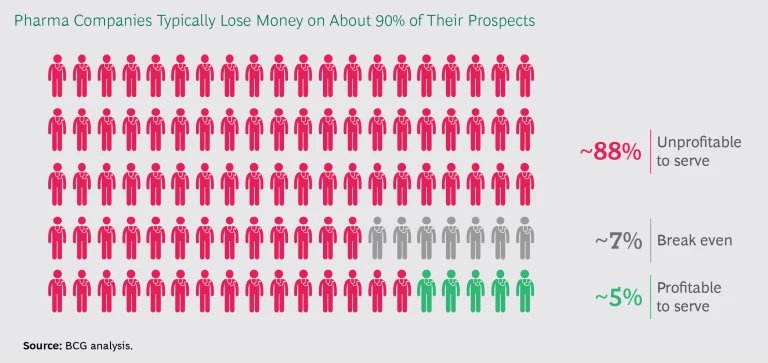Pharma companies have worked to increase their sales team’s return on investment for as long as sales representatives have been detailing products. Although research shows that loyal customers drive the vast majority of pharma sales, sales teams continue to spend massive amounts of time and money pursuing elusive prospects that might—just might—become loyal prescribers.
In our work with clients, we have seen pharma sales teams unlock significantly more value from their commercial model by following three simple steps: double down on your loyalists; prune your prospects; and create and deploy more agile and efficient hunting models.
Step 1: Double Down on Your Loyalists
After the first two to three years following a product’s launch, almost all incremental sales growth comes from increasing the prescription volume of physicians who have already adopted the product, not from converting new prescribers. In fact, for nearly every brand whose performance we reviewed over the past decade, more than 90% of growth came from the base of prescribers who began using the product regularly within three years of launch.
In interviews and focus groups, physicians tell us that they formulate their personal “prescribing algorithm” for any new product relatively quickly—and absent the release of new clinical information, they rarely change it. Physicians who have relegated a product to third or fourth line, or who have not adopted it at all, are very unlikely to change their prescribing behavior, no matter how frequently a pharma company’s sales representatives call on them.
On the other hand, physicians who adopt a product early in its life cycle and initially use it with only a subset of their patients are much more likely to prescribe it for more types of patients over time. The main source of growth for most US brands after launch comes from physicians prescribing a product to a broader set of patients.
What does this mean for commercial teams? It’s simple: double down on your loyalists. Identify the physicians who regularly prescribe your products, and focus on them with laser-like intensity. Often, the top 30% to 40% of physicians that a sales force calls on drive 80% to 95% of sales. Too often, commercial teams reduce their call frequency to these loyal customers in order to free up capacity to try to convert prospective customers. This is a mistake, which brings us to our second simple step.
Step 2: Prune Your Prospects
We define a prospect as any physician who is not a regular prescriber of a pharma product. During a product’s launch period, virtually every physician is a prospect. But over time, the mix of regular prescribers and prospects stabilizes.
With most US pharma products—especially those that are well advanced in their life cycle—companies allocate 30% to 40% of their sales force’s time to calling on prospects. But in most instances, our analysis shows, only 3% to 7% of prospects ever become profitable after the initial postlaunch period.
Note that we do not advocate ignoring prospects altogether. They treat patients, and these patients deserve access to life-improving and life-saving treatments. The key is to find cost-efficient ways to cultivate and educate prospects, and then to systematically identify the small percentage who may become regular prescribers of a product.
Step 3: Create and Deploy More Agile and Efficient Hunting Models
How can commercial teams more efficiently target and convert the most promising prospects? We recommend two approaches.
The first is to assemble a “SWAT team”—a small group of sales representatives who are very good at hunting for prospects and know how to make a compelling case for physicians to try a product they don’t currently prescribe. These teams use customer relationship management data, as well as prescribing data, to determine which prospects have the highest potential for conversion. The sales reps schedule longer sessions (often half a day at the office) to meet with all stakeholders, including office staff, to explain the product’s benefits and to address any barriers that might keep physicians from prescribing it. Having a medical representative on hand to field more technical questions is also helpful.
The second approach is to use analytics to determine the optimal moments to engage prospects. Pharma companies have access to various types of data—from prescribing information to online activity—that they can monitor to identify certain patterns indicating individual physicians’ readiness to change their prescribing behavior. For instance, they can flag physicians who prescribe a new medication or a medication different from their usual one, or who search the pharma company’s website for new information. At that point, the sales team receives an alert to engage the prospect, this time with a much higher probability of conversion. In effect, the pharma company uses technology to engage the right customer with the right information at the right time, vastly improving its odds of success.
The most expensive commercial investment for most pharmaceutical companies is their sales force, which often costs tens, if not hundreds, of millions of dollars each year. By implementing the three simple steps described here, pharma executives can obtain significantly higher productivity and efficiency from this spending and can position their products to have a considerably greater impact for patients, physicians, and shareholders.











